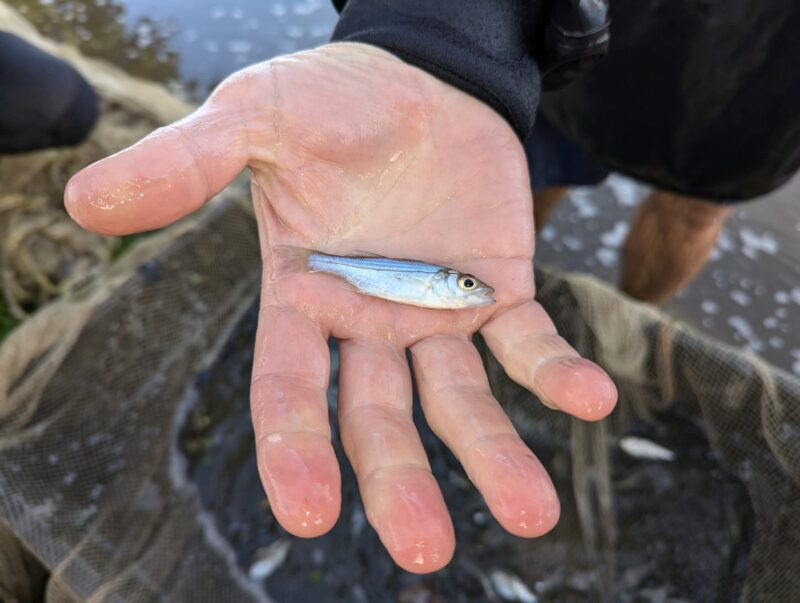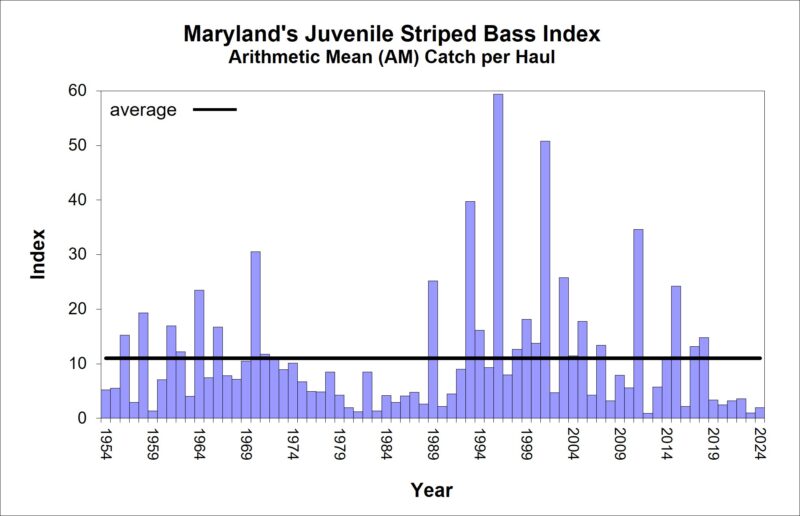
A juvenile striped bass caught and released by a survey crew in the Nanticoke River. Photo by Joe Zimmermann, Maryland DNR.
The Maryland Department of Natural Resources announced results of this year’s juvenile striped bass survey, which tracks the reproductive success of Maryland’s state fish in the Chesapeake Bay.
The 2024 young-of-year index is 2.0, well below the long-term average of 11.0, and marks the sixth consecutive year of poor reproduction.
“These results underscore the complexity of managing a coastal migratory species whose life-cycle is influenced by environmental conditions during a brief spawning period,” said Maryland DNR Fishing and Boating Services Director Lynn Fegley. “We will continue to explore ways to conserve and enhance the spawning population during this time when we are adding fewer young fish to the population.”
During this annual survey, fishery managers examine 22 sites located in four major striped bass spawning areas: the Choptank, Nanticoke, and Potomac rivers, and the upper Chesapeake Bay. Biologists visit each site three times per summer, collecting fish with two sweeps of a 100-foot beach seine net.
The index represents the average number of young-of-year striped bass found in each sample. The juvenile striped bass average less than 3 inches long and are not usually encountered by anglers. Similar fish surveys conducted this summer in the Patapsco, Magothy, Rhode, West, Miles, and Tred Avon rivers found fewer striped bass, also known as rockfish.
Biologists captured more than 56,000 fish of 56 different species while conducting this year’s survey. Encouraging results were documented regarding two species lower on the food chain. Menhaden abundance was nearly equal to last year, which was the highest measured since 1990. Spot abundance was the highest measured since 1988. These species are vital to the ecology of the Bay as a food source for many other species of fish and wildlife.
Efforts to rebuild the Atlantic Coast population of striped bass have been ongoing for several years. Although recent population estimates indicate improvement, low levels of reproduction will influence future conservation measures under consideration by the Atlantic States Marine Fisheries Commission.
In recent years, Maryland has implemented management actions aimed at rebuilding the spawning stock, including reductions to catch limits, increased protections for spawning fish, tighter slot limits, and season closures.
However, warm conditions in winter continue to negatively impact the reproductive success of striped bass, whose larvae are very sensitive to water conditions and food availability in the first several weeks after hatching. Other species with similar spawning behavior such as white perch, yellow perch, and American shad also experienced below-average reproduction this year.
The below-average year classes will likely become more apparent among the adult population of striped bass in the coming years, as the juveniles reach maturity.
While environmental conditions hamper reproductive success, fisheries managers focus conservation efforts on adult striped bass so that the spawning population can produce a strong year class when environmental conditions are favorable.
The Virginia Institute of Marine Science conducts a similar survey in the southern portion of Chesapeake Bay.

A juvenile striped bass caught and released by a survey crew in the Nanticoke River. Photo by Joe Zimmermann, Maryland DNR.



